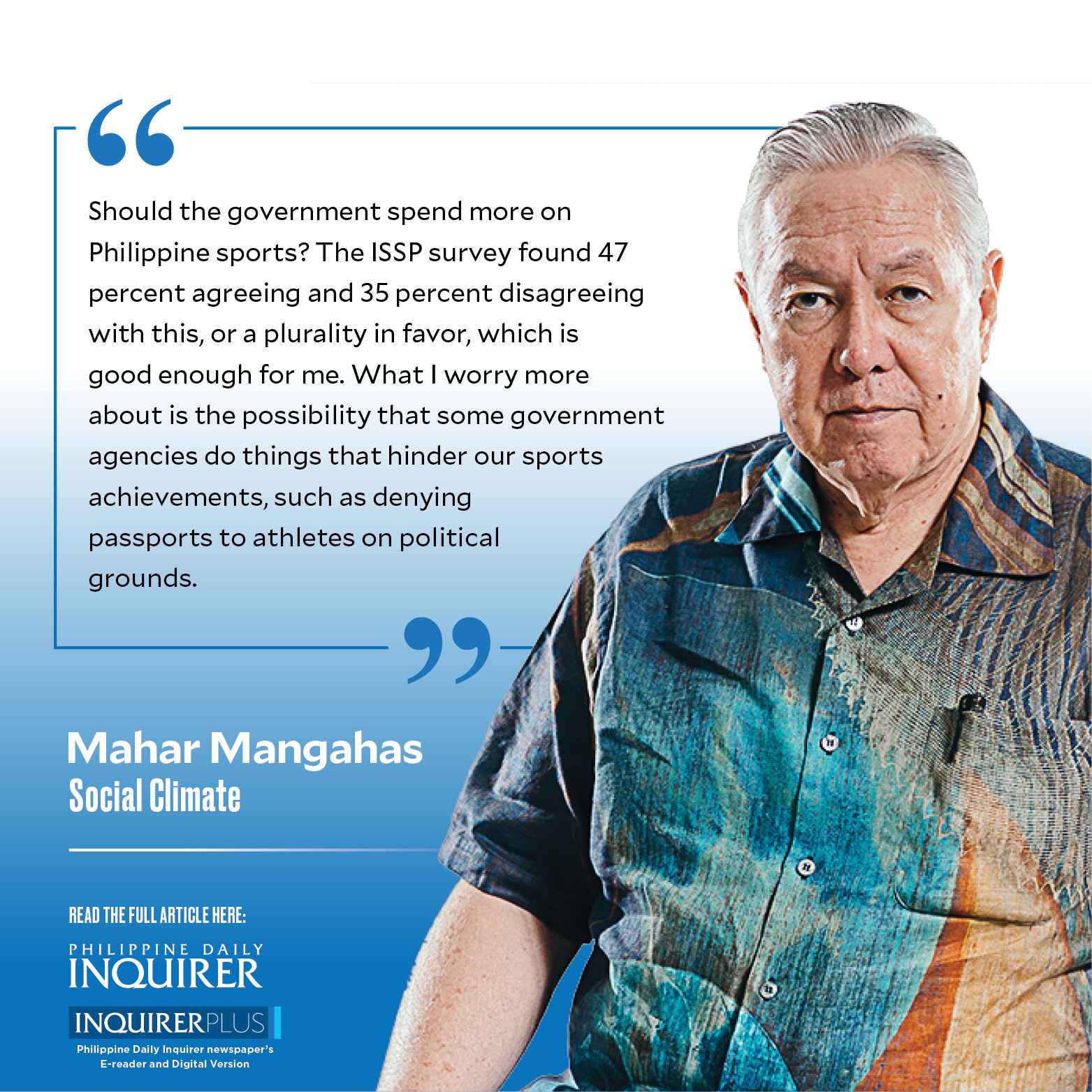Justifiable national pride

The national pride referred to here is the performance of the Philippines in international sports.
The evidence that such pride exists is the 2007 round of the International Social Survey Programme (issp.org), which was on the topic of Sports and Leisure. That round was done in 33 countries, including the Philippines. It has not yet been repeated; the ISSP’s standard replication time is about 10 years, so maybe it will be refreshed soon.
Here is the survey item of focus: Gaano ninyo ipinagmamalaki ang Pilipinas tuwing nagwawagi sa pang-internasyonal na isport o laro? How proud are you when Philippines does well at an international sports or games competition?
Answer choices: Aking talagang ipinagmamalaki (I am very proud); Aking medyo ipinagmamalaki (I am somewhat proud); Aking hindi masyadong ipinagmamalaki (I am not very proud); Aking talagang hindi ipinagmamalaki (I am not proud at all); Hindi makapili (Can’t choose).
For the Philippines, where the survey was done by Social Weather Stations on 3/30-4/2/2008, the ISSP Sports survey had the following national adult percentages: Very Proud 74, Somewhat Proud 19, Not Very Proud 5, Not At All Proud 2, and Can’t choose 1.It so happens that the Philippines ranks third in the ISSP data—the only global data set I know of—in terms of the percentage Very Proud: 1. Dominican Republic 86, 2. South Africa 79, 3. Philippines 74, 4. Taiwan 67, 5. Croatia 66, 6. Chile 65, 7. Ireland 62, 8. South Korea 62, 9. Poland 60, 10. Australia 60, 11. New Zealand 59, 12. Uruguay 58, 13. Argentina 57, 14. Russia 56, 15. United States 53, 16. Bulgaria 53, 17. Slovenia 53, 18. Latvia 51, 19. Czechia 51, 20. Mexico 50, 21. Hungary 49, 22. Great Britain (part of United Kingdom) 44, 23. Slovakia 43, 24. Japan 41, 25. Israel 39, 26. Germany 38, 27. Austria 36, 28. Sweden 36, 29. France 28, 30. Norway 28, 31. Flanders (part of Belgium) 27, 32. Switzerland 26, and 33. Finland 24.
(ISSP has 45 countries now, many more than back in 2007. India in particular was not yet in ISSP then; but since joining, its India member has done its share of the work. China likewise was not yet a member, but the present membership for China needs government permission to conduct each specific topic. Each country member pays its own costs, by the way.)
The average sports survey result for the entire set of 33 countries was 54 percent Very Proud, 31 percent Somewhat Proud, 6 percent Not Very Proud, 3 percent Not At All Proud, and 5 percent Can’t Choose. The typical country has a small majority very proud, and almost a third somewhat proud.
It is clear, therefore, that we Filipinos are top-ranked in terms of pride in our performance in international sports competitions. This means competition in all sports in general, not merely in those sports that happen to be featured in the Asian Games, Olympic Games, and the like.
There are many international sports achievements that Filipinos are justifiably proud of. We have Manny Pacquiao, the boxer. We have Efren “Bata” Reyes, the billiards “magician,” and many more bilyaristas in his footsteps. We have Paeng Nepomuceno, the multidecade bowling champion. How about Arianne Cerdeña, who won the gold for bowling in the 1988 Olympics, when it was “a demonstration sport”? And Eugene Torre and Wesley So in chess?
How about the other sports that are unconventional to much of the world, such as arnis (stick-fighting)? How about cockfighting in particular? My good friend Tony Hidalgo (+), cock breeder and author of cockfighting books, used to tell me that the Araneta Coliseum is the cockfighting center of the world.
Filipino aficionados will have their respective favorite sports. According to the ISSP sports survey, pinays (73 percent) and pinoys (75 percent) are equally very proud of our sports achievements. By age, the very proud range is between 71 percent in age 18-24 to 80 percent in age 35-44. Geographically, the percentage for very proud is 82 in the National Capital Region, 77 in Balance Luzon, 67 in Visayas, and 69 in Mindanao.
Should the government spend more on Philippine sports? The ISSP survey found 47 percent agreeing and 35 percent disagreeing with this, or a plurality in favor, which is good enough for me. What I worry more about is the possibility that some government agencies do things that hinder our sports achievements, such as denying passports to athletes on political grounds.
—————-
Contact: mahar.mangahas@sws.org.ph.




















